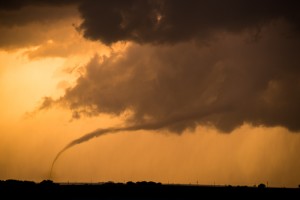Where’s My Seasonal Tornado Forecast?
The nation’s experts on tornadoes, derechos and other types of “severe convection” had a meeting of the minds earlier this month at Columbia’s Lamont campus to discuss ways of advancing our poor understanding about how the frequency and occurrence of these storms are related to climate variability and change. They also presented the latest efforts at predicting these events on a practical scale.
Currently, the prediction of tornado activity more than a few days ahead of time is considered difficult, if not impossible. Last year, Michael Tippett, from the International Research Institute for Climate and Society and his colleagues Adam Sobel and Suzana Camargo from the Lamont-Doherty Earth Observatory, showed that climate information might help make extended-range forecasts feasible—but that was only a start.
The three scientists decided it was a perfect time to jump-start progress in this nascent field and organized the two-day workshop.
Scientists who study severe storms and those who study climate tend to operate in different circles and rarely communicate with each other, says Sobel.
“We saw a similar situation a decade ago between the hurricane and climate communities,” Sobel says. “Back then, what it took was a concerted effort of those two groups talking to each other, telling each other what they were doing wrong and learning from each other to make progress,” he says.
“The important first step was to get the right people in the same room,” says Tippett. These included researchers from the National Oceanic and Atmospheric Administration, the Massachusetts Institute of Technology, Pennsylvania State University, the National Center for Atmospheric Research as well as representatives from the insurance industry.
“Just by having these disparate groups together, we identified some actions which could be done now and would really have good success,” Tippet says. For example, the severe-weather researchers helped the climate scientists identify key parameters that they should save from their model outputs for later analysis.
“One of the points scientists learned from the re-insurance participants was that despite the high-impact of tornadoes, losses from hail are a bigger concern for the industry,” he says.
For Tippett, the workshop showed there is a lot of promise and progress being made toward understanding severe convection. “Even though we currently can’t make computer models of tornadoes because they are too small and too complex, we’re getting close,” Tippett says. “If we decide to put effort and resources into it, I think we can do a lot right now.”
Learn more on the current state of tornado/climate research by watching the video interviews below.
1. Why a workshop for predicting severe storms and tornadoes?
Adam Sobel and Michael Tippett reflect on the workshop they convened with colleague Suzana Camargo, why the time was right and why the Earth Institute was the perfect place to host it.
2. The president asked, where’s my seasonal tornado forecast?
Hear from Harold Brooks from NOAA’s National Severe Storms Laboratory and Michael Tippett on the state of tornado prediction. Alice Underwood from Willis Re North America explains why insurance companies are keen to be part of the discussion.
3. How will climate change affect tornadoes and severe storms?
Lamont’s Adam Sobel, Harold Brooks and Michael Tippett tell it like it is.


You must be logged in to post a comment.